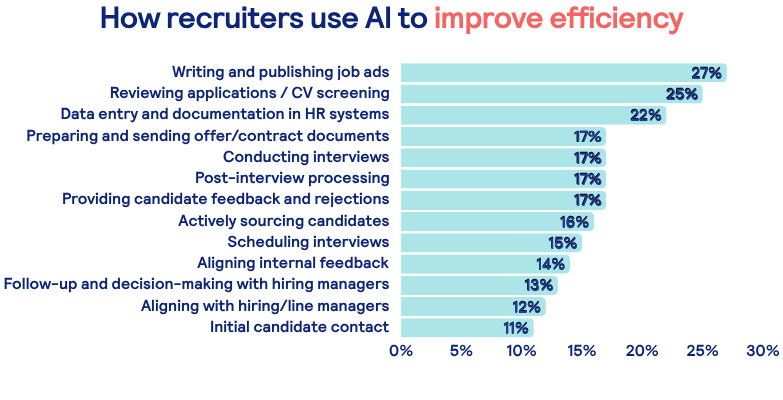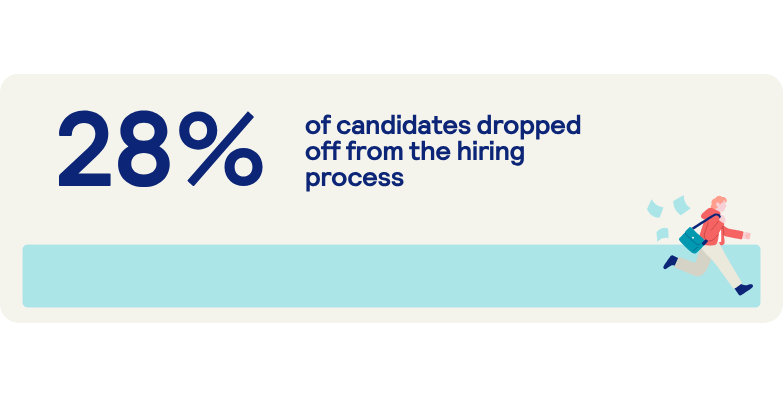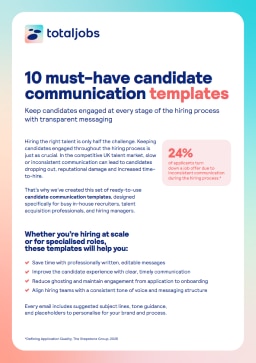
How to use ChatGPT in recruitment
Table of Contents
- What is ChatGPT?
- Leveraging ChatGPT in recruiting
- Getting started with ChatGPT
- A new kind of recruiting assistant
- FAQs

Decoding Global Talent: Work Preferences in the Age of GenAI
Recruitment is a rapidly changing landscape, with artificial intelligence (AI) tools like ChatGPT leading the charge.
With employers and staffing agencies alike looking to increase speed and efficiency in their hiring processes, ChatGPT is helping automate everyday tasks, engage with candidates more efficiently, and ultimately reduce time-to-hire.
This article explores the role of ChatGPT in talent acquisition and how it can be used to drive efficiency in hiring. Let’s dive in.
What is ChatGPT and how does it work?
ChatGPT is an advanced language model developed by OpenAI that uses AI to understand and generate human-like text based on the input it receives. It’s trained on vast amounts of data, enabling it to comprehend context, answer questions, and produce coherent, relevant responses across a wide range of topics.

Importantly, it learns from the prompts you provide, so the more specific and detailed your input, the better and more relevant the output will be. This makes ChatGPT a versatile assistant that can adapt to various different tasks.
The benefits of using ChatGPT in recruitment
Many organisations are increasingly adopting generative AI tools like ChatGPT in their recruitment process, and for good reason.
By utilising these tools, many are able to include a range of desirable benefits, including:
- Accelerating the hiring process by automating routine tasks
- Freeing recruiters to focus on critical thinking and decision-making
- Enhancing candidate engagement with faster, consistent communication
How to leverage ChatGPT in recruiting
The good news is that setting up a ChatGPT account is free, and OpenAI has a suite of easy-to-use tutorials to help you get up to speed.
When it comes to recruitment, there are numerous ChatGPT can lighten the workload and drive process efficiency.
Let’s take a look at some specific examples.
1. Writing job descriptions and adverts in seconds
Our research shows that creating job ads takes up valuable recruiter time, an average of 2.8 hours per vacancy, contributing to over 17.7 hours of admin work per role. For team members managing multiple openings each month, this adds up quickly. In fact, the hidden cost of manual hiring tasks per recruiter annually is estimated at £16,728.
ChatGPT can significantly reduce this workload with its ability to create job descriptions that appeal to top candidates in seconds. You can input role-specific details and desired tone, and the tool will create job adverts optimised for clarity, tone, and inclusion.
This is especially useful in high-volume or repeat hiring environments, where consistency and speed matter. With 27% of recruiters already using AI to write and publish job ads, the adoption curve is moving fast.
By producing well-written, compelling ads, ChatGPT can help maximise visibility and attract more qualified potential candidates.

Example prompt: “Write a compelling, inclusive job advert for a mid-level Software Engineer role based in Manchester. Emphasise flexible working, growth opportunities, and required skills like Python, REST APIs, and AWS. Use a professional but friendly tone.”
2. Generating tailored interview questions
Interview preparation is a major efficiency bottleneck. Recruiters and hiring managers often rely on outdated templates or scramble to prepare questions that are inconsistent across panels. With recruiters on average managing four roles a month, and each requiring multiple interviews, prep time stacks up fast
ChatGPT helps streamline this by instantly generating custom, role-specific interview questions, ranging from technical assessments to behavioural and situational scenarios. This supports more structured interviews, helps maintain fairness, and ensures that even less experienced interviewers can confidently assess candidates.
This is critical in a context where too many interview rounds and poor stakeholder availability are cited as top interview inefficiencies by employers (up to 34% of large businesses). Consistency also supports better internal alignment when feeding back or comparing candidates.
You can even request ChatGPT to generate scoring criteria, red flag indicators, or follow-up prompts, improving both the speed and quality of your interview process.

Example prompt: “Create a list of 10 structured interview questions for a Customer Success Manager role. Include a mix of behavioural, competency-based, and situational questions focused on communication, problem-solving, and account management.”

Explore our free guide on conducting candidate interviews.
3. Drafting candidate feedback and rejections
Post-interview admin remains one of the most time-consuming and inefficient parts of the recruitment process. We found that recruiters spend around 3 hours per vacancy on post-interview processing and rejection communication, often juggling messy notes, incomplete feedback, and high candidate expectations.

With 28% of candidates dropping out of the hiring process, and 25% of these saying it’s because the process took too long, improving communication speed is essential. Another 23% cite poor communication and 21% say role expectations were unclear, all areas that timely, thoughtful feedback can address.
ChatGPT helps by drafting professional, warm rejection messages based on candidate stage and interview outcome. It can also:
- Summarise interview notes
- Create internal feedback documentation
- Suggest follow-up questions for hiring managers
All of this can help to improve candidate experience, reduces churn, and take repetitive admin off recruiters’ plates.
Given that 17% of recruiters are already using AI for post-interview processing and another 17% for feedback and rejections, it’s clear that this use case is delivering measurable time savings while preserving empathy in communication.

Example prompt: “Write a warm and professional rejection email for a candidate who completed a second-round interview for a Product Manager role. They interviewed well but lacked experience with B2B SaaS. Encourage them to apply again in the future.”
How to get started with ChatGPT in recruiting
Now that you understand the potential of ChatGPT to transform your recruitment efforts, it’s time to take the first steps toward integrating this powerful tool into your workflow.
Here’s a simple roadmap to help you get started:
- Explore the technology and choose your platform: Begin by familiarising yourself with ChatGPT or similar AI language models available on the market. Many platforms offer free trials or demo versions, giving you the chance to test their capabilities without commitment. Consider your team’s needs and the level of integration you require when selecting a solution.
- Dedicate regular time for experimentation and learning: Allocate consistent, focused time—whether it’s 30 minutes a week or a few sessions per month—to explore how ChatGPT can support your recruiting tasks. Use this time to experiment with different prompts, evaluate outputs, and refine your approach. Treat this as an ongoing learning process, allowing room for trial, error, and gradual improvement.
- Create a collaborative learning environment: Encourage your teams and stakeholders to engage with ChatGPT together. Form a small working group or community of practice where members can share insights, successful use cases, and challenges. Collaboration fosters creativity and accelerates adoption, while also building collective confidence in leveraging AI tools.
- Set clear goals and measure impact. Define what success looks like for your ChatGPT adoption, whether its reducing time spent on writing job ads, improving candidate communication, or streamlining interview preparation. Track progress against these goals to understand the ROI and identify areas for further optimisation.
- Stay informed and connected. The AI landscape evolves rapidly. Follow thought leaders, industry experts, and AI-focused communities on social media and professional networks to stay updated on best practices, new features, and innovative use cases in recruitment. This ongoing engagement will help you stay ahead and continuously enhance your AI-driven hiring process.
A new kind of recruiting assistant
ChatGPT is not replacing recruiters, it’s enhancing them. By automating admin and improving communication, it gives recruiters back time to focus on strategy, quality, and human connection.
Frequently asked questions
Can ChatGPT replace human recruiters in the hiring process?
No, ChatGPT is designed to assist recruiters by automating repetitive and time-consuming tasks, such as writing job descriptions or drafting candidate communications. Human judgement, empathy, and critical decision-making remain essential to effective recruitment and should always be at the core of the hiring process.
How can recruiters get started with ChatGPT if they have no technical background?
Getting started is straightforward. Many platforms offer user-friendly interfaces and tutorials. Recruiters can begin by experimenting with simple prompts to generate job ads or interview questions, gradually building confidence. Forming a team learning group and setting clear goals can also ease adoption without requiring technical expertise.
What are some practical ChatGPT use cases for recruitment teams?
ChatGPT can help with a variety of tasks including drafting inclusive job descriptions, generating tailored interview questions, summarising candidate profiles, creating structured feedback, and composing professional rejection emails. These use cases save time and improve consistency and candidate experience.
How can organisations measure the impact of ChatGPT on their recruitment process?
Organisations should define clear objectives such as reducing time-to-hire, increasing candidate engagement, or cutting down administrative workload. Tracking metrics like time spent on job ad creation, candidate response rates, and recruiter productivity before and after ChatGPT adoption can help quantify its benefits and guide ongoing optimisation.
Explore articles
Receive the latest recruitment resources and
advice to boost your hiring
By providing us with your details you agree to our privacy policy and for us to keep you updated with the latest news, events,
and special offers from Totaljobs.









